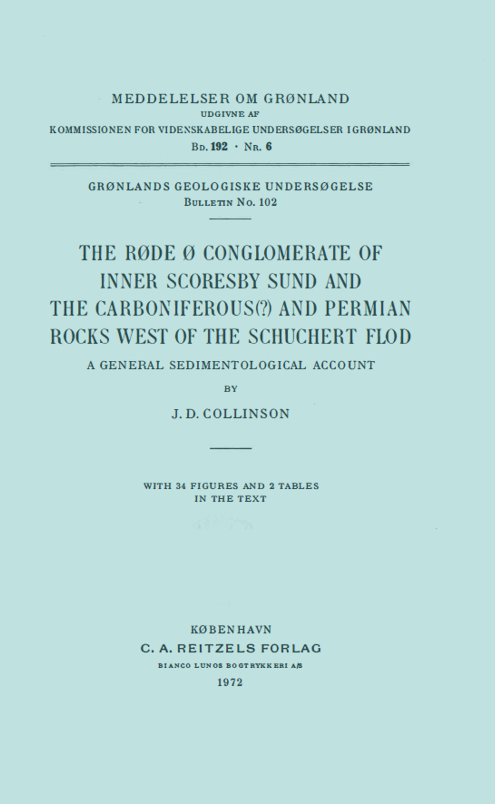The Røde Ø Conglomerate of Inner Scoresby Sund and the Carboniferous (?) and Permian Rocks West of the Schuchert Flod. A General Sedimentological Account.
DOI:
https://doi.org/10.7146/mog.v192.150071Resumé
The Røde Ø Conglomerate is a formation of red sandstones and conglomerates in the inner part of Scoresby Sund. It has an elongated north-south outcrop within an area of high-grade metamorphic rocks. It is bounded on the west by a normal fault, downthrowing to the east and dying out northwards. The sediments rest unconformably on migmatites along their eastern boundary. Within the R0de 0 Conglomerate, four lithofacies associations are recognised. A conglomerate association is the most abundant and occurs along the western side of the outcrop against the fault. It is coarse and poorly sorted, and easterly palaeocurrents are suggested. The association is interpreted as the product of alluvial fans building eastwards. This association passes laterally eastwards through an interbedded complex into a silty sandstone association which, in turn, passes into a gypsiferous sandstone association. These are both thought to be largely suspension deposits at the distal limit of the fans. The gypsum is the result of near surface precipitation due to high evaporation. On Store, on the eastern side of R0defjord and east of the other associations, a cross-bedded sandstone association referable to a normal fluviatile model occurs. Palaeocurrents here were to the north and north-west. It is suggested that movements along the western boundary fault were probably the cause of the rapid uplift needed to supply the coarse sediment. The rocks west of the Schuchert Flod were described by KEMPTER (1961} who
recognised three major subdivisions, the Bjørnbos Corner Formation of alleged Carboniferous age, the Gurreholmsdal Formation (Lower Permian) and the Karstryggen Group (Upper Permian). The Bj0rnbos Corner Formation is an arkosic conglomerate whose sedimentation is not obviously related to any presently observed tectonic feature. The Gurreholmsdal Formation shows a pattern of sedimentation broadly similar to the R0de 0 Conglomerate with conglomerates in the west, near the Stauning Alper Fault passing eastwards and downcurrent into finer arkoses and eventually into micaceous sandstones which have northerly palaeocurrents. Sediment supply is again thought to have been due to movement on the western fault margin. It is not possible to date the Røde ø Conglomerate by comparison with the Schuchert sequence in any conclusive way, though it can be tentatively suggested that the same regional tensional event might have been responsible for both sedimentary events.

Downloads
Publiceret
Citation/Eksport
Nummer
Sektion
Licens
Coypyright by the authors and the Commision for Scientific Research in Greenland. No parts of the publications may be reproduced without the consent of the copyright holders.

